Overview
A lobectomy is a procedure that is used to remove one of the lung’s lobes. Lobes are divisions found within the lungs. The right lung contains three lobes. There are 2 lobes in the left lung. When an issue is detected in only one lung, lobectomy surgery may be performed. The diseased lobe is eliminated in this surgery, allowing the undamaged lung tissue to function normally. Most frequently, a lobectomy is performed during a procedure termed as a thoracotomy. The chest is exposed in this kind of operation.
The cut performed during a lobectomy is typically made at the region of the damaged lobe. The cut is typically done around the nipple at the front of the chest and extends around to the backside underneath the shoulder blade. The surgeon can eliminate the lobe by accessing the chest cavity further through revealed ribs.
Lobectomy surgery may occasionally be performed as video-assisted thoracoscopic surgery (VATS), which is less harmful procedure to undertake. Instead of making one major cut, in this kind of surgery, three or four small cuts are made. The chest cavity is inspected using tiny instruments in this procedure. The thoracoscope is one of these instruments. A small camera and illumination tube transmit images to a monitor screen. The internal organs are shown on a monitor. To conduct this procedure, the little instruments are inserted through the other wounds.
The lobectomy surgery cost varies depending on the severity of the conditions and other medical conditions associated with it. The average lobectomy surgery cost in India is INR 2 to 3 lakhs.
Why is lobectomy surgery needed?
When an issue is identified inside one lobe, a lobectomy surgery may be performed. To prevent illness from spreading across the other lobes, a lobe may well be eliminated. This might apply to lung cancer or even certain cases of TB.
Conditions related to the chest and lungs that can be addressed with lobectomy surgery include:
- Emphysema – This is a long-term condition brought on by breaking down of the lungs' elastic tissues. The lungs have considerable difficulty expanding as a result of this condition.
- TB (Tuberculosis) – This bacterial infection is persistent (chronic) and frequently affects the lungs.
- Lung abscess – This is a potential pus-filled lung region. Antibiotic medication may not be enough to clear up the infection; surgery may be required.
- Lung cancer – This particular kind of tumour can damage the bronchi, which are the primary airways towards the lungs, one or even more lung lobes, the pleural wall, as well as other lung tissue. This can expand to certain other body areas if left untreated.
- Benign tumour – This development is not cancerous. However, other organs' functioning may be impacted and large blood arteries may be compressed due to this condition.
- Fungal infection – Infections can be caused in the lungs due to the fungi growing inside the body.
Types of lobectomy surgery
Two different non-invasive (not harmful) lobectomy techniques exist: video-assisted thoracoscopic surgery (VATS) and robot-assisted thoracoscopic surgery (RATS).
In both cases, the surgeon works with instruments inserted between the ribs across a small chest opening (incision). This method prevents doctors from breaking or spreading the ribs. The more invasive option involves developing a sizable cut and separating the ribs to access the lung.
Those who are recommended to undergone non-invasive lobectomy surgery include the people with a type of lung cancer that is in stages I through III, lung carcinomatous (cancer-like cells) growth, lung cancer having small cells in stage I, or a singular lobe of the lung that has undergone damage from an infection.
Traditional thoracotomy – In this procedure, the damaged lung lobe is extracted through a wide cut made on the chest’s side during a typical thoracotomy open surgical operation.
Measures to be taken for lobectomy surgery
The technique will be explained to you by the medical professional. If you want to know anything or need to get any doubts clarified, you can approach and talk to this medical professional. Consider bringing a friend or relative to write notes and ensure that all of your queries are addressed. A consent form authorising the surgery may be given to you for signature. Examine the form thoroughly. If something is unclear, ask questions and get clarification before signing.
Before the surgery, you could undergo blood testing or other examinations or tests such as a CT scan, PET scan, chest X-ray, and ECG.
Inform your medical professional if you:
- are considering becoming pregnant or already are pregnant
- are sensitive to iodine or contrasting dye
- are allergic to any medications, rubber, tapes, or anaesthetics
- take any medications, including prescribed and non-prescribed drugs, as well as vitamins, herbal, and dietary supplements
- Have a bleeding condition
- Use aspirin, ant blood-thinning medication, or any other medications that can have an impact on blood clots Further measures to be taken include the following:
- If advised to do so by your healthcare professional, stop taking specific medications before the surgery.
- Observe any instructions given regarding not consuming anything before the procedure.
- Quit smoking.
- Arrange to have a driver take you from the hospital to your apartment.
- Observe any additional guidelines that your healthcare provider may suggest. What happens during a lobectomy?
- You won't experience any discomfort throughout your lobectomy operation because you'll be unconscious.
- Your breathing will be controlled by a catheter in the neck.
- Your arm will be attached to an IV so that you can get medication through it. These lobectomy surgery process steps will then be carried out by the surgeon –
- The surgeon will create a tiny incision between the ribs on the chest's side. They will make 2 to 3 one-inch incisions and just one 2-inch incision in the chest to enable entry to the chest cavity for a VATS as well as RATS lobectomy without widening the ribs.
- Surgical tools and a thoracoscope (a tiny video camera) will then be inserted into the incisions. In the operating theatre, the doctor will conduct the procedure by utilising screens that provide a good visualisation of the lung.
- If a preliminary diagnosis couldn't be made, wedge biopsies of the lesion will be taken. If cancer is found later or before the operation, the lobe will be removed by disconnecting the strands of both the blood vessels as well as airways entering that area of the lung while leaving the arteries and airways to the remaining lung undamaged.
- The sample will be extracted by pulling the tissue through one of the tiny incisions by using a specialised sack.
- Enough surrounding tissue would be eliminated to ensure the complete removal of the tumour.
- To check for minute cancer spread, the lymph nodes in the chest will be examined.
- The doctor will ensure that there are no bleeding areas.
- They then will sash out the inside of your chest.
- Finally, the doctor will sew the wounds tightly.
What happens after a lobectomy surgery?
You may have to spend some time in the recovery room following the surgery. As you awaken from general anaesthesia, you would feel tired and disoriented. The team of doctors will keep an eye on your vitals, including your pulse and breathing.
If you require pain medication, it will be administered to you. Immediately following the procedure, a chest X-ray could be taken to ensure that the lungs are healthy. You'll spend several days in the hospital post-lobectomy surgery.
The incision site could include one or even more chest catheters to remove liquid or gas from the chest. As you start moving, coughing, or taking heavy breaths, the chest tubes could hurt. Before your hospital discharge, catheters will be removed.
To aid the lungs in recovering post-surgery, deep breathing techniques and coughing practices will be explained to you. These techniques aid you in breathing and guard you against pneumonia. A while after the operation, you could require oxygen. The oxygen cylinders will typically be turned off before you return home.
You'll be instructed to move as frequently as possible. The quicker you start going for walks, your lungs will heal faster. A few hours following surgery, you can be handed liquids to consume. Food will be provided for you to consume as much as possible. Your follow-up consultation with the health professional will be scheduled before you leave for home. When the healthcare professional gives the all-clear, you will return home. You'll need a ride home from somebody.
Maintain the wound clean and dry at home. You'll receive showering instructions from your healthcare professional. During a subsequent visit, the stitches will be taken out. In the initial few days, the wound could be unpleasant. Your shoulders and chest muscles might hurt, especially after sneezing, hard breathing, or vigorous exercise.
You can take painkillers as prescribed by your doctor. Certain painkillers, including aspirin, may make bleeding worse. Be careful to take only the medications that your doctor has prescribed.
Continue practising the breathing techniques taught to you in the hospital. As you are able, steadily increase the physical activity. A few weeks may pass before everything is back to normal. During a few months, you might have to avoid lifting anything heavy. After an open-chest procedure, lobectomy rehabilitation normally requires a 4 to 5 days stay at the hospital.
Recovery time required after lobectomy surgery
The hospitalisation time will likely be between 2 and 3 days if you choose the less severe VATS or RATS lobectomy. In general, recovery is quicker with VATS or RATS than that with standard thoracotomy since the pain is less in RATS or VATS. A quicker return to employment and daily tasks is a benefit of these two techniques.
Following VATS or RATS, you will have to take narcotic painkillers for almost a week when you return home. The majority of individuals don't need a refill. After you arrive at home, you ought to be capable of supporting yourself. This indicates that you are self-sufficient and don't need a helper.


